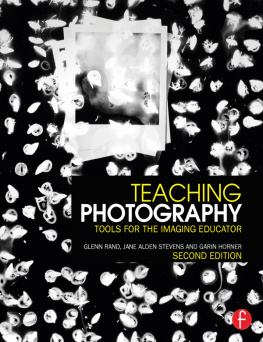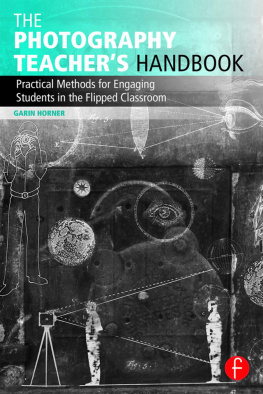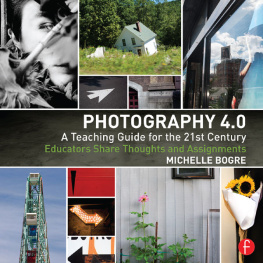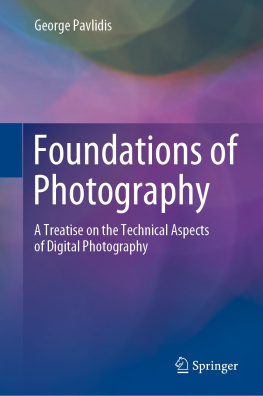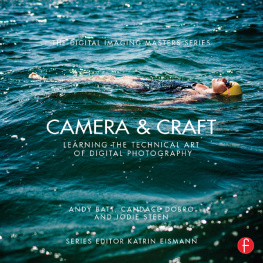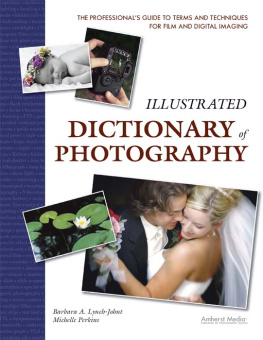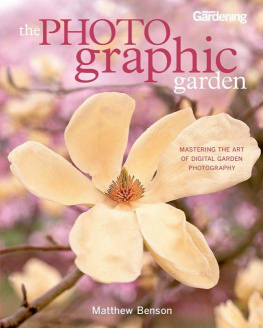Teaching Photography
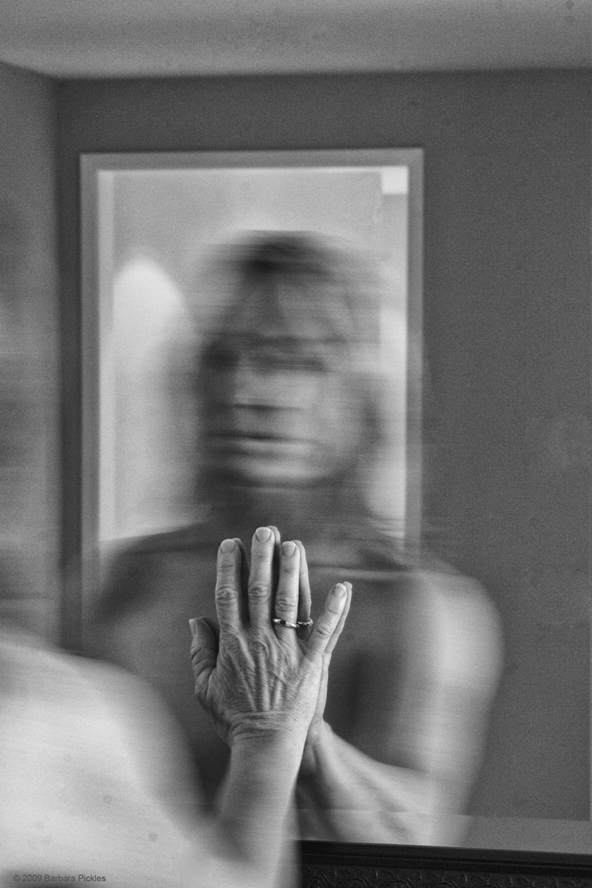
To Light; by Barbara Pickles, student of Tim Bradley
Teaching Photography
Tools for the Imaging Educator
Second Edition
Glenn Rand
Jane Alden Stevens
Garin Horner
Cover image: No. 7 from Light Compositions; by Joe Addison, student of Carol Golemboski
First published 2006 by Focal Press
This edition published 2015
by Focal Press
70 Blanchard Road, Suite 402, Burlington, MA 01803
and by Focal Press
2 Park Square, Milton Park, Abingdon, Oxon OX14 4RN
Focal Press is an imprint of the Taylor & Francis Group, an informa business
2015 Taylor & Francis
The right of Glenn Rand, Jane Alden Stevens and Garin Horner to be identified as authors of this work has been asserted by them in accordance with sections 77 and 78 of the Copyright, Designs and Patents Act 1988.
All rights reserved. No part of this book may be reprinted or reproduced or utilized in any form or by any electronic, mechanical or other means, now known or hereafter invented, including photocopying and recording, or in any information storage or retrieval system, without permission in writing from the publishers.
Notices
Knowledge and best practice in this field are constantly changing. As new research and experience broaden our understanding, changes in research methods, professional practices or medical treatment may become necessary.
Practitioners and researchers must always rely on their own experience and knowledge in evaluating and using any information, methods, compounds or experiments described herein. In using such information or methods they should be mindful of their own safety and the safety of others, including parties for whom they have a professional responsibility.
Product or corporate names may be trademarks or registered trademarks, and are used only for identification and explanation without intent to infringe.
Library of Congress Cataloging in Publication Data
Rand, Glenn, author.
Teaching photography : tools for the imaging educator / Glenn Rand,
Jane Alden Stevens, Garin Horner.
pages cm
First published 2006 by Focal PressTitle page verso.
Includes bibliographical references.
1. PhotographyStudy and teaching. I. Stevens, Jane Alden, author.
II. Horner, Garin, author. III. Title.
TR161.R36 2015
ISBN: 978-1-138-83854-3 (pbk)
ISBN: 978-1-138-84590-9 (hbk)
ISBN: 978-1-315-73423-1 (ebk)
Typeset in Berling and Futura
By Keystroke, Station Road, Codsall, Wolverhampton
Dedicated to the memory of Richard D. Zakia (19252012)
Richard (Dick) Zakia embodied the goals of this book. He was totally committed to the life of photographic education. Through his many books his spirit lives on. He was the gentlest of men, who through his energies encouraged others to learn, love, and teach photography. For the authoring team of this book Dick was an inspiration, teacher, mentor, co-author, and most of all, a great friend.
Contents
Teaching is a noble profession and we are blessed to be part of it.
In starting this second edition we must acknowledge that many of the attributes of this book have been brought forward from the first edition co-authored by Richard Zakia. You will notice the hallmark of Dicks style by the inclusion of many quotations from both famous individuals and from our colleagues and friends in the photographic education community. As with the first edition, these quotations are there to enlighten and enrich the experience of reading this book.
This book is not intended to be a cookbook. We have not tried to tell of assignments or approaches that can be used to teach specific photographic techniques. Instead this book takes a broader view of photographic education aimed at enhancing the experiences of both the teacher and the learners striving to acquire photographic skills.
Simply stated, this book is about the collaboration of teaching and learning that occurs between teacher and student. We are committed to the concept that, for learning to happen at the highest level, a teacher must possess a solid understanding of effective teaching strategies in order to guide the learner through the processes, technologies, and aesthetics that make photography a truly beautiful language.
The book was envisioned, in this edition as in the first, as inclusive of voices and ideas beyond our own. We see the learning activities involved in photography the same way as we see the construction of this book. Many ideas coalesce about the central direction of photographic education that enables learners to become successful photographers. In support of this, the student photographs included in the book indicate the faculty member who taught, assisted, or guided the student in their photographic journey.
This book would not have come to fruition were it not for the efforts of Kimberly Duncan-Mooney, Denise Power and the talented staff at Focal Press. Along with those who contributed directly to the book we are indebted to the support that we received from our families.
Finally, we wish to thank you for choosing to pursue teaching photography and for selecting this book to assist you in your quest.
GR/JAS/GH

Ecstasy; by Garin Horner, student of Carl Toth
You cannot teach a man anything; you can only help him find it within himself.
Galileo Galilei
From Garin Horner
Cranbrook Academy of Art is an enchanting place, especially for artists. The interplay of the European architecture, the magnificence of the grounds, and the bountiful panorama of artwork express the high level of creativity cultivated there.
There is a feeling, when one first enters the walled grounds, of leaving the world behind and entering an artists Shangri-La. Its the kind of place where an artist can thrive, and years ago it was a place I remember seeing myself thriving in. But, even more important than the aesthetic pull of Cranbrooks atmosphere was the connection I felt with Carl Toth, the Master of Fine Arts programs Photography Artist in Residence. When a student chooses an undergraduate degree, it is based on the qualities of the institution. With a graduate degree, its much more important to choose an institution based on the qualities of the programs primary teacher. For this reason, acceptance into the Master of Fine Arts program at Cranbrook was most important to me.
Even before my first meeting with Carl, I had a picture in my head about what he would be like. His Xerographic constructed images always held an allure, but because of his reputation I wanted to learn from him. I did my research and spoke with some of his students before actually meeting him. Among Carls students he was commonly referred to as A true genius and beloved educator at Cranbrook. He had a reputation for being humble, thoughtful, and remarkably insightful. Carl was quiet, but when he spoke about photography it was compelling in the way he could expose within photographs that which somehow remained unseen by most people. He could also reveal insights into the intentions, purposes, and life of a photographer, based on their images. Carl was a master of recognizing the interplay of elements framed within the borders of a print and the way that photographic expression can intimately speak about the inner thoughts of its maker.

